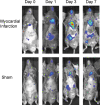Post-infarct remodelling: contribution of wound healing and inflammation
- PMID: 18977766
- PMCID: PMC2639128
- DOI: 10.1093/cvr/cvn292
Post-infarct remodelling: contribution of wound healing and inflammation
Abstract
In human and experimental myocardial infarction (MI), cessation of blood supply leads to rapid necrosis of cardiac myocytes in the ischaemic heart. Immediately after injury, various intra- and intercellular pathways contribute to healing the myocardial wound in order to achieve tissue integrity and function. MI and the consequent loss of myocardium are the major aetiology for heart failure. Despite aggressive primary therapy, prognosis remains poor in patients with large infarction and severe left ventricular dysfunction. Thus, it would be highly desirable to improve healing of the cardiac wound to maintain structure and function of the heart. Healing in the heart occurs in overlapping phases. Herein, we review the inflammatory phase as a trigger of tissue formation.
Figures




References
-
- McKay RG, Pfeffer MA, Pasternak RC, Markis JE, Come PC, Nakao S, et al. Left ventricular remodeling after myocardial infarction: a corollary to infarct expansion. Circulation. 1986;74:693–702. - PubMed
-
- Ertl G, Frantz S. Healing after myocardial infarction. Cardiovasc Res. 2005;66:22–32. - PubMed
-
- Frantz S, Bauersachs J, Kelly RA. Innate immunity and the heart. Curr Pharm Des. 2005;11:1279–1290. - PubMed
-
- Janeway CA., Jr Approaching the asymptote? Evolution and revolution in immunology. Cold Spring Harb Symp Quant Biol. 1989;54(Pt 1):1–13. - PubMed
-
- Akira S, Uematsu S, Takeuchi O. Pathogen recognition and innate immunity. Cell. 2006;124:783–801. - PubMed
Publication types
MeSH terms
Substances
LinkOut - more resources
Full Text Sources
Medical

